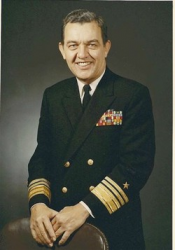
 |
|
|
||
|
Jerome H. King, Jr. |
||||
|
Engagements: • World War II (1941 - 1945)• Korean War (1950 - 1953)• Vietnam War (1960 - 1973) |
||||
| Biography: | ||||
|
Jerome H. King, Jr. Jerome H. King, Jr. was born on 14 July 1919 in Youngstown, OH. King graduated from Yale University with a Bachelor degree in Engineering in 1941; he was also in the Navy ROTC program at Yale. He received a Master's Degree in Nuclear Physics from the Massachusetts Institute of Technology in 1951 and became an authority on the effects of nuclear weapons. . In 1958, he completed the Senior Course at the Naval War College. He began his Navy service in the Pacific during World War II and first rose to prominence in the late 1950s when Admiral Thomas H. Moorer was commander of Carrier Division Six, which operated mostly in the Mediterranean. Moorer took note of King's ability as a Surface Operations Officer, who coordinates and directs operations of carrier formations at sea, and became his mentor. Moorer proved to be a very valuable and influential mentor, as he later became the Chief of Naval Operations and Chairman of the Joint Chiefs of Staff. Moorer helped his protégé win several important jobs that included demanding assignments at sea and in the front offices of the Navy hierarchy. In 1969, Rear Admiral King was Commander of an anti-submarine warfare group when he was asked to lead a delicate assignment. He was the senior member of a joint U.S.-Australia board of inquiry into a fatal collision between the U.S. destroyer USS Frank E. Evans and the Royal Australian Navy aircraft carrier Melbourne during NATO maneuvers on 3 June 1969 in the South China Sea. The panel, over which King presided, primarily faulted the actions of the U.S. destroyer, which was sheared in half after turning at night in front of the carrier. Seventy-four U.S. sailors died. Some questioned his review of the crash because he was the Commanding Officer of both forces involved in the military exercise. In 1970, King became one of earliest Navy ROTC graduates to achieve the rank of three-star Vice Admiral. Until then, almost all vice admirals had been U.S. Naval Academy graduates. Admiral Moorer then gave King the difficult public task of succeeding then-Vice Admiral Elmo R. Zumwalt Jr. as Commander of Naval Forces in Vietnam and as Chief of the Naval Advisory Group for Vietnam. Reporting to Saigon in 1970, King continued the work started by Zumwalt in overseeing the transfer of the Navy's small coastal and river combat boats to the South Vietnamese. This assignment was part of the U.S. strategy called "Vietnamization" in which the South Vietnamese took over more responsibility for military operations. "Vietnamization became frustrating to King because it wasn't the same desire to victory that had existed before," said historian Paul Stillwell, who conducted an oral history with Vice Admiral King. "He presided over the diminishment of American capability there," Stillwell said, "and was not always confident of the South Vietnamese ability or willingness to take over the equipment and the roles" of the U.S. Navy operating in rivers and canals. After an 11-month tenure in Saigon, King was assigned as Deputy Chief of Naval Operations for Surface Warfare. From 1972-74, as the Director of Operations of the Joint Chiefs of Staff he was a key aide to Admiral Moorer, who was then serving as Chairman of the Joint Chiefs of Staff. He retired from the Navy in 1974. Medals and Awards Distinguished Service Medal (3 Awards) In Retirement After retiring from the Navy, King moved to Southern California for a consulting position with Research and Development Associates in Marina del Rey. He was a resident of Palos Verdes Estates until his death. Death and Burial On 13 June 2008, Vice Admiral Jerome H. King, Jr. was attending his granddaughter's graduation ceremony at the California Institute of Technology. He was wearing a '41 Yale baseball cap - a tribute to his alma mater, which was also where he got an early start on his long U.S. military career. He collapsed during the ceremony and was rushed to Huntington Memorial Hospital in Pasadena, where he died. He had chronic obstructive pulmonary disease and pneumonia. He is buried at Arlington National Cemetery in Arlington, VA. King's first marriage to Jane Bellows King ended in divorce. Survivors include his wife of 22 years, Annette Neely King of Palos Verdes Estates; three daughters from his first marriage, Judith Griggs of Norcross, GA, Anne McFarland of San Diego and Sally King of Snohomish, WA; two stepsons, retired Navy Commander Timothy McElhannon of Lexington, VA, and Stephen McElhannon of Woodstock, GA; six grandchildren; and two great-grandchildren. |
||||
| Honoree ID: 2712 | Created by: MHOH | |||
Ribbons
Medals
Badges
Honoree Photos
 |  |  |
 |  |
 |


